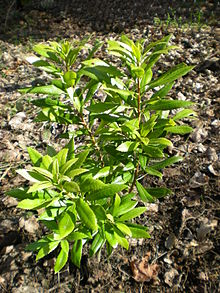- Myrica californica
-
Myrica californica 
Scientific classification Kingdom: Plantae (unranked): Angiosperms (unranked): Eudicots (unranked): Rosids Order: Fagales Family: Myricaceae Genus: Myrica Species: M. californica Binomial name Myrica californica
Cham. & Schltdl.Synonyms Morella californica
Myrica californica (California Bayberry, California Wax Myrtle or Pacific Wax Myrtle; syn. Gale californica (Cham. & Schltdl.) Greene, Morella californica (Cham. & Schltdl.) Wilbur) is an evergreen shrub or small tree native to the Pacific Ocean coast of North America from Vancouver Island south to California as far south as the Long Beach area.
It grows to 2-10 m tall, and has serrated, sticky green leaves 4-13 cm long and 0.7-3 cm broad, which emit a spicy scent on warm days. The flower's inflorescence is arranged in a spike 0.6-3 cm long, in range of colors from green to red. The fruit is a wrinkled purple berry 4-6.5 mm diameter, with a waxy coating, hence the common name wax myrtle. This species has root nodules containing nitrogen-fixing microorganisms, allowing it to grow in relatively poor soils.
Cultivation and uses
It grows well on cool, moist coastlines and can be planted in lines as a seaside windbreak. The bark and leaves have historically been used on occasion for gastrointestinal ailments. The most active chemical is apparently the glycoside myricinic acid, which is related to saponin. The plant tissues are also high in tannins. The wax may be extracted from the fruit and made into candles and soap; however, this species produces much less wax than other bayberries, and so is rarely used for this purpose.
External links
- Flora of North America: Myrica californica
- Jepson Flora Project: Myrica californica
- USDA Plants Profile
- Photo gallery

This Fagales article is a stub. You can help Wikipedia by expanding it.
